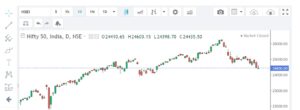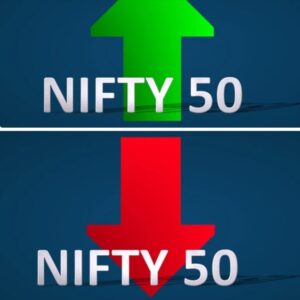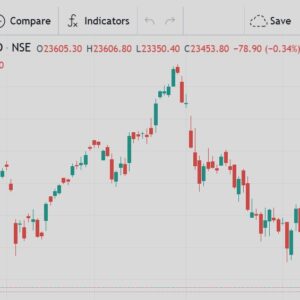What is Nifty ETF? A Comprehensive Guide to Nifty Exchange-Traded Funds
In recent years, Nifty ETFs (Exchange-Traded Funds) have gained significant attention among investors looking for diversified, low-cost exposure to the Indian stock market. An ETF is a type of investment fund that holds a collection of assets, such as stocks, bonds, or commodities, and is traded on exchanges like individual stocks. A Nifty ETF specifically tracks the performance of the Nifty 50 index, making it an ideal investment for those looking to participate in the growth of India’s top companies without selecting individual stocks. In this guide, we provide a detailed overview of Nifty ETFs, explaining how they work, their benefits, risks, and how they fit into an investment portfolio.
Understanding the Basics of Nifty ETFs


What is the Nifty 50 Index?
The Nifty 50 index, often simply referred to as Nifty, is one of India’s most prominent stock indices. It consists of the 50 largest and most liquid stocks listed on the National Stock Exchange of India (NSE), representing a wide range of sectors, from financial services and information technology to pharmaceuticals and consumer goods. This index serves as a barometer of the Indian economy and is widely tracked by both domestic and international investors.
What is an ETF?
An Exchange-Traded Fund (ETF) is a type of investment fund that holds a basket of securities and is traded on the stock exchange, similar to a stock. Unlike traditional mutual funds, ETFs are continuously traded on the exchange throughout the day, and their price fluctuates based on supply and demand. Investors can buy or sell ETFs at market prices during trading hours, providing them with liquidity and flexibility.
What is a Nifty ETF?
A Nifty ETF is an exchange-traded fund designed to replicate the performance of the Nifty 50 index. It holds a portfolio that closely resembles the composition of the Nifty 50, thereby providing investors with exposure to India’s top-performing companies. By investing in a Nifty ETF, individuals essentially own a share of each company in the index, proportionate to the index’s structure.
How Nifty ETFs Work
Nifty ETFs are designed to mirror the Nifty 50 index’s performance. This replication can be achieved through either full replication or partial replication:
- Full Replication: In this approach, the ETF holds all the stocks in the Nifty 50 index in the exact proportions as the index. This provides highly accurate tracking of the index’s performance.
- Partial Replication: In some cases, the ETF may hold a sample of the Nifty 50 stocks that closely resembles the index. This method is typically employed to reduce transaction costs, particularly when there are illiquid stocks in the index.
Each Nifty ETF has a Net Asset Value (NAV) that reflects the combined market value of the stocks within the ETF. The NAV fluctuates throughout the trading day based on the prices of the underlying stocks in the Nifty 50. Investors buy and sell units of the ETF on the stock exchange, with prices determined by market forces.
Advantages of Investing in Nifty ETFs
1. Diversification
One of the primary benefits of investing in a Nifty ETF is diversification. By holding an ETF, investors gain exposure to 50 large, established companies across multiple sectors, thereby reducing the risk associated with investing in individual stocks. This diversity helps mitigate sector-specific and company-specific risks, providing a balanced portfolio.
2. Low Cost
Nifty ETFs are generally more cost-effective compared to actively managed mutual funds. The fund management fees, known as expense ratios, are lower because ETFs typically follow a passive investment strategy by mirroring an index. As a result, investors benefit from lower management fees and transaction costs.
3. Liquidity and Flexibility
Since Nifty ETFs are traded on the stock exchange, they offer high liquidity. Investors can buy or sell ETF units at any time during trading hours, allowing them to quickly respond to market movements. This flexibility makes Nifty ETFs a suitable option for both long-term investors and short-term traders.
4. Transparency
The portfolio of a Nifty ETF is typically transparent, as it follows the Nifty 50 index, which is publicly available. Investors can easily track the ETF’s holdings and performance, enabling them to make informed decisions. This transparency is a significant advantage over some mutual funds that may not disclose their holdings as frequently.
5. Dividend Reinvestment
Some Nifty ETFs reinvest dividends paid by the underlying stocks, which can enhance returns over time. This reinvestment allows the NAV to grow, contributing to the investor’s overall capital appreciation. Dividend reinvestment in ETFs can lead to compounded growth, particularly for long-term investors.
Potential Risks of Nifty ETFs
1. Market Risk
As with any equity investment, Nifty ETFs are subject to market risk. If the Nifty 50 index declines due to adverse economic conditions, corporate performance issues, or global factors, the value of the Nifty ETF will also decrease. Investors should be prepared for market volatility and ensure their risk tolerance aligns with this investment.
2. Tracking Error
Although Nifty ETFs aim to replicate the Nifty 50 index, there can be slight discrepancies between the ETF’s performance and the actual index performance. This discrepancy, known as tracking error, can occur due to various factors such as management fees, trading costs, and dividend reinvestments. Tracking errors can impact the accuracy of the ETF’s performance in relation to the Nifty 50 index.
3. Liquidity Risk
While Nifty ETFs are generally liquid, there can be instances where liquidity is limited, particularly in volatile or low-volume markets. Low liquidity can affect the ease with which investors can buy or sell ETF units at favorable prices, potentially leading to higher transaction costs.
How to Invest in Nifty ETFs
Investing in Nifty ETFs is straightforward, and investors can purchase units through their stockbroker or online trading platform. Here’s a step-by-step guide to investing in Nifty ETFs:
- Open a Demat and Trading Account: A Demat account is necessary to hold ETF units, while a trading account enables you to buy and sell on the stock exchange.
- Choose a Nifty ETF: Several financial institutions offer Nifty ETFs, including SBI Nifty ETF, HDFC Nifty ETF, and ICICI Prudential Nifty ETF. Compare their expense ratios, tracking accuracy, and liquidity before making a choice.
- Place Your Order: During market hours, place a buy order for the desired quantity of Nifty ETF units through your trading platform. You can choose to invest a lump sum or use a systematic investment plan (SIP) to invest regularly.
- Monitor and Adjust: Once invested, monitor your ETF’s performance and make adjustments as needed. As Nifty ETFs track the Nifty 50 index, periodic adjustments are minimal, but investors should stay informed about market trends.
Comparing Nifty ETFs with Other Investment Options
Nifty ETFs vs. Actively Managed Mutual Funds
While both Nifty ETFs and actively managed mutual funds provide diversified exposure to the stock market, they have distinct differences:
- Cost: Nifty ETFs generally have lower expense ratios than actively managed funds because they follow a passive investment strategy.
- Performance: Actively managed funds aim to outperform the index but may not always succeed. Nifty ETFs aim to replicate the Nifty 50 index, so they provide returns close to the index performance.
- Liquidity: ETFs can be traded throughout the day, while mutual fund transactions are processed only at the end of the trading day.
Nifty ETFs vs. Direct Stock Investment
Investing directly in stocks requires extensive research and is associated with higher risk due to lack of diversification. Nifty ETFs, on the other hand, offer instant diversification and require less active management, making them suitable for investors seeking steady, long-term growth.
Who Should Consider Investing in Nifty ETFs?
Nifty ETFs are well-suited for a range of investors:
- Long-term Investors: Those seeking long-term capital growth with lower costs may benefit from the passive investment style of Nifty ETFs.
- New Investors: Nifty ETFs offer a convenient entry point for new investors looking to participate in the stock market without choosing individual stocks.
- Traders: Due to their liquidity and flexibility, Nifty ETFs also appeal to traders seeking short-term profit opportunities.
Conclusion
Nifty ETFs provide a versatile, cost-effective way to invest in India’s top 50 companies while enjoying the benefits of diversification, liquidity, and transparency. As a passive investment vehicle, they offer returns closely aligned with the Nifty 50 index, making them an excellent choice for both new and experienced investors. However, as with all investments, it is essential to consider the associated risks, including market risk and tracking errors, before making a decision. For those interested in participating in the growth of India’s stock market, Nifty ETFs offer an efficient and accessible option.









